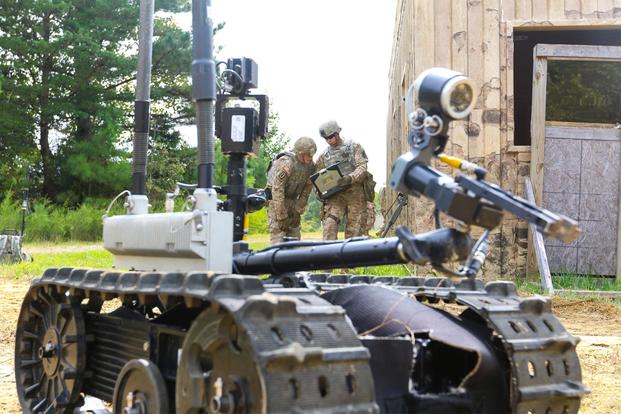 Army maneuver officials are hoping that a consortium of experts in non-military robotics can find new ways for combat units to defeat the enemy, especially in dense urban terrain. The Army's Capabilities Development and Integration Directorate, or CDID, at Fort Benning, Georgia, recently partnered with the National Advanced Mobility Consortium to conduct an outcome-based innovation workshop -- an approach to challenges that has been "proven in the commercial industry sector but never potentially used in a partnership with the military to get after some of the military's problems," according to Col. Tom Nelson, the head of CDID's Robotics Requirement Division.
Army maneuver officials are hoping that a consortium of experts in non-military robotics can find new ways for combat units to defeat the enemy, especially in dense urban terrain. The Army's Capabilities Development and Integration Directorate, or CDID, at Fort Benning, Georgia, recently partnered with the National Advanced Mobility Consortium to conduct an outcome-based innovation workshop -- an approach to challenges that has been "proven in the commercial industry sector but never potentially used in a partnership with the military to get after some of the military's problems," according to Col. Tom Nelson, the head of CDID's Robotics Requirement Division.
The consortium recently had discussions with various groups, such as soldiers from 3rd Battalion, 75th Ranger Regiment; Army captains from the Maneuver Captains Career Course; and Training and Doctrine Command officials representing Army infantry, armor and Stryker brigade combat teams.
Between now and April, the consortium will consider tactical problems and potential solutions involving robotics and autonomous systems, Nelson said.
Army officials are hopeful that the group can help develop a solution that can be used for precision engagement in close urban terrain, for dealing with enemy forces that hide among the population in large cities.
"I like to use the example, you can't blow up a zip code to kill a mailbox," said Don Sando, director of CDID.
"How do you go after that mailbox, or that individual or small unit that is taking it upon themselves to hide and protect themselves in an environment that they know you are going to have difficulty going after," he said.
The Army, he said, thinks robotics can help soldiers do just that.
"In an ideal world, he said, "we can make it where it is very affordable and your mission payload is either a riot-control agent or some kind of concussion or, on the high-end, some kind of lethal effect ... delivered by a robotic and autonomous system under the control of a soldier."
Another problem the group wants to go after is how to more effectively provide combat leaders with a more-defined, "common operating picture" of the battlefield, Nelson said.
"We think that robotic and autonomous will allow us to do that in a way that we haven't been able to do in the past," Nelson said.
"If you think about a battalion scout platoon on a screen line -- how can a robotic and autonomous system assist in producing situational awareness and then feeding that [to soldiers] so they see things on the battlefield? ... How does that become something that a decision maker can use?"
The consortium will continue to work the problem and hopes to present either prototypes or white papers describing solutions during the National Defense Industry Association's National Robotic Conference in April, Army officials said.
"It's just an opportunity to help us look at the problem differently, and they may come up with the same answers that we have been looking at for years ... but I suspect that they may come at it a little differently," Sando said.
In the past, the Army has gone to industry with a problem and said, "here is kind of what we think is a way to solve that problem with an [unmanned aerial system] or a ground robot," Nelson said.
"We are not providing that to them. All they want at this point is the problem and the data that helps define that problem. So hopefully they can come up with something that hasn't been looked at before."
-- Matthew Cox can be reached at matthew.cox@military.com.
No comments:
Post a Comment